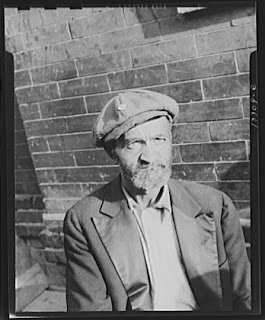 |
| Seaton Place, 1949 |
In what is coined the Strivers Section today, the 1700 block of Seaton Place, located between U, V, 17th Streets and Florida Avenue, was first developed in the early 1870s, and completed by 1908. It was the subject of noted photographer Gordon Parks in 1942, as part of his work documenting the effects of racism and poverty for the Farm Security Administration, seen below. Adjoining both the Greater U Street and Dupont Circle Historic Districts, the Strivers Section Historic District was recognized and listed as a local historic district in 1983.
Seaton
Place today was initially coined Riggs Street, as seen on an 1887 map of Square
150. It was then renamed a short time
later to Seaton Road, in honor of William Winston Seaton, mayor of Washington
from 1840 to 1850. Later, its name was
changed to Seaton Place.
The oldest buildings along the one
block street are located at 1701 to 1719
Seaton. Erected between 1872 and 1873,
this row of ten, two-story brick dwellings featured raised basements and Italianate
detailing including a bracketed wood cornice.
Another group of rowhouses on the south side at 1700 to 1716, were also
built relatively early, from 1874 to 1875.
It originally consisted of a row of ten, two-story, flat fronted brick
dwellings on high foundations to appear as if it were one long building. The end buildings at 1700 and 1716 were
articulated as “end pavilions” with projecting center gables, with the center
buildings forming the main block of the group.
Today, the homes are all painted different colors, and one end pavilion
(#1716) is no longer standing.
Development
on the Street ceased for nearly fifteen years, until 1890, when the thirteen
rowhouses between 1741 and 1757 Seaton Place were built simultaneously by builder
James H. Grant as speculative housing.
The five townhouses from 1731 to 1739 Seaton were also built in 1890, by
owner John C. Davidson, with the assistance of architect George S. Cooper. The 1900 census reveals that all the built
segments of Seaton Street at the time housed “Black and Mulattos”
occupants.
 |
| Peanut seller, by Gordon parks |
However,
much of Seaton Place remained vacant until 1902, most likely due to the
economic depression of 1893 and 1894, and the years of recovery that
followed. Eighteen houses were built that
year by owner Charles W. King with the assistance of architect Nicholas T.
Haller, comprising 1722 to 1758 Seaton Place.
The three large townhomes at 1723, 1725, and 1727 were built in 1905 as
“townhouse flats” by building partners
Jos. J. Moebs and H..J. O’Connor. Each
included an apartment that was indicated by using a 1/2 after the residential
address. The two estimated the three
dwellings would cost $7,000 to build, or approximately $2,333 each. The last house built to complete the block
was 1720 Seaton Place, built in 1908 by owner C.T. Bride with the assistance of
architect J.G. Adkinson and builder J.T. Loveliss. The 1920 census reveals that all the
residents along Seaton Street were “Black or Mulatto” working class citizens at
the time.
Apparently,
from the late 1940’s to the late 1970’s, Seaton Street, was the focus of
disagreements between tenants, home owners, and the city government over the
terrible conditions of the houses. It
was well documented as part of the 1942 Farm Security Administration’s “New
Deal” Program, and later in an essay on Wartime Washington by photographer
Gordon Parks (b. 1912), whose photographs are now housed in the Library of
Congress. Recognized as the first major
black photojournalist, Parks later went on to become a staff photographer for Life magazine.
In the
August 3, 1950 edition of the Washington Star, a short notice appeared
indicating the anticipated revival of Seaton Street and the entire Square 150,
containing an slightly amusing statement on the street itself:
Square 150 Rehabilitation Unit to Resurvey Job
The Commissioner’s Committee appointed to rehabilitate
Square 150 will make a resurvey of the block next Monday, E.M. Dulin, chairman
announced today.
Square 150 is bounded by U, V, and 17th streets and
Florida avenue, N.W.
There are 124 buildings in the square, and 20 of them
have been or are in the process of being repaired. The
worst part of the square is Seaton street, which runs from Seventeenth
Street to Florida Avenue, N.W.
Nine years
later, on 25 September 1959, the Washington Daily News ran a story by
Martha Strayer with a by-line coined “Massive Aid: the World Comes to a D.C.
Street.” In an effort to better
conditions, almost every department in the government made a commitment to
provide education, better sanitation, and relief to the unimaginable
conditions. At the time, the one block
Street housed 200 children!
The
“acknowledged block of blight” was saved demolition in 1965, when the National
Capitol Planning Commission voted against the idea in February of that
year. According to a 2 May 1965 article
in the Washington Post, the reason given was the lack of public housing
for the 130 families on the block at the time.
Commission staffers still wanted to revitalize the Adam’s Morgan area,
and at one time investigated purchasing the empty property at 16th and Florida,
previously “Henderson Castle,” a mansion that had been demolished in 1949.
At least
some of the residents won the lawsuit in the D.C. Superior Court (10 of the
original families) in April of 1977, and had a short time to raise funds to
remain in their homes. In May of that
year, at least nine of those families were able to purchase their homes,
according to a 30 November 1978 article in the Washington Post, a few of whom can still be proudly found on the block today.
Copyright Paul K. Williams


